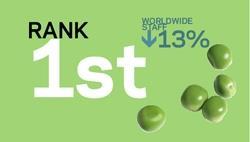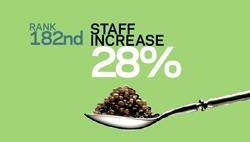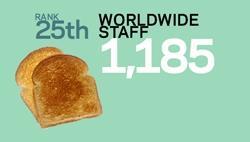The year’s tables of the UK biggest consultants show that many of them have too many mouths to feed, which means they will face painful choices in the next 12 months. Roxane McMeeken looks at how they got into this position. To accompany the tables, which are will , we asked five top executives for three predictions for the next 12 months. The data was collected by Martin Hewes
It has been a lean year for the industry’s consultants. Twelve months ago, our annual report on the state of play for the UK’s largest 250 consultants described an industry that was expecting the public sector to cut its rations, although we didn’t know which party would be writing the menu. Now we know a bit more, and it looks like the industry will be dining on shoe broth and nettle soup for the next year or so - but we still don’t know exactly how much of that we’ll be getting. We’ll have to wait until the Comprehensive Spending Review on 20 October to find out.
As sometimes happens when the food runs short, firms are turning to cannibalism: two large consultants, Davis Langdon and Scott Wilson, have been eaten by gigantic American rivals (Aecom and URS, respectively). Others have succumbed to their hunger, like Archial, the architect that went into administration last month (although that has now been resuscitated by Ingenium, a Toronto-based multidisciplinary consultancy).
This year’s Top 250 comes at a dramatic time. Reassuringly, perhaps, some things have remained constant. For instance, Atkins is still the biggest consultant in our rankings (which are based on UK chartered staff), and it has also retained its grip on the number one spot in the fee earners’ table.
Unfortunately, that’s more or less it for the reassuring stuff, because our survey of consultants’ views and strategies has revealed that the amount of work around, and the fees that consultants are charging for it, are not enough to match their staffing levels. This may be bearable in the short term, but with yet more belt-tightening in the offing, something will have to give.

What’s going wrong
To understand how consultants got to this point, you only need to look at ��ɫ����TV’s previous top 250 surveys. They show that, in the years of feast between the second
Labour landslide in 2000 and the run on Northern Rock in 2007, consultants grew ever fatter and wealthier, and their principal concern was finding ever more staff, so they could take on even more work. The point of maximum consumption was reached in the middle of 2007. Since then orders have fallen 30%. The point of maximum employment was reached a year later, in 2008, but by contrast that has fallen by only 13%. Martin Hewes, the economist who carried out the research for ��ɫ����TV, puts the problem this way: “The inflow of new work is now back to where it was in 2003, yet consultant employment levels are 28% above what they were then.”
42% of companies rely on the public sector for more than half of their fee income
Brian Johnson, chairman of architect Aedas, which is 31st in the top 250 table and 5th in the architects’ league, is aware of the gap between staffing and workload. He says: “There is an issue, but the problem is that when you have uncertain workloads it’s hard to match your resources to them - and then profitability suffers.”
Another reason, says Johnson, is that “lots of consultants have invested large amounts of money in training their staff, so they don’t want to lose them. They also feel it’s not worthwhile paying for redundancies now as they’ll need those staff when things pick up.”
The strategy doesn’t work
Our research shows this reactive strategy has been proven not to work. In the 2008 survey, when the financial crisis was at high tide, 70% of respondents said they planned to increase staffing levels. A year later, in the 2009 survey, 96% of respondents said they had laid off staff.
Are you planning to increase your percentage of overseas fee income? Yes 57%
It was the same with salaries. In the 2008 survey, 96% of respondents said they planned to increase pay, yet in the 2009 survey only 17% of actually did so. Hewes says: “Consultants have been behind the curve, reacting and adjusting to the reality of harsher trading conditions as opposed to anticipating them.”
This year’s survey also found that 52% of firms plan to leave employment levels stable and 20% of companies plan to raise them (compared with 14% in 2009). Again, their claims on pay levels are following the trend, with some 76% of firms planning to increase them.
By contrast, 83% of firms expect trading conditions to stabilise or worsen, and 91% are either concerned or very concerned about the public sector cuts. This is not surprising, as 42% of companies derive half or more of their income from the public sector.
The over-retention of staff could just about be sustained if the market picks up by 2012 and, in particular, if the private sector comes back in time to make up for plummeting public sector workloads. But economists are sceptical about this possibility. Hewes says: “The most likely scenario is workloads remaining near to current levels, even by 2012.” He points to “continued stagnation in the housing and commercial markets - in part owing to weak employment and restrictive lending”, along with a sharp fall in public sector investment. Hewes predicts it will fall by about 30% between 2010 and 2013. “Given that the public sector accounts for close to 40% of new construction work, a 30% fall in public new work over the period 2010-13 can only be offset by a 7-8% annual increase in private work over the same period, which is a highly unlikely scenario.”
On average what are your margins? less than 3% 11%
As Johnson points out, falling workloads coupled with relatively high staffing levels mean falling margins. Several findings in our survey bears this out. For instance:
- In 2007, 5% of companies reported margins below 3%; in 2010, the reading was 11%
- In 2007, 56% of firms reported margins greater than 8%, by 2010 this had slipped to 43%
- In 2007, 56% of firms reported rising margins; by 2009 this had slipped to 9%
- It has since risen to 16%, although on balance companies are experiencing lower margins.
Hewes says: “If workloads fail to rise by 2012, and consultants hang on to staff, their margins will suffer further.” Anecdotal evidence suggests most consultants are charging fees that are at least 50% lower than before the downturn.
So what will happen? Well, further redundancies appear inevitable. Richard Steer, senior partner in Gleeds (10th in the QS league and 20th in the main ranking), says: “Unfortunately the sector will have to lose more people. We have adjusted to the fall in private sector work, but now there’s the public sector to deal with.”
However, the picture is not entirely bleak, as consultants do have other tricks up their sleeves. Aedas, for example, has laid off 10% of staff since the start of the downturn and currently derives 40% of its UK turnover from the public sector (see profile page 43). Johnson says the firm is “fully prepared for this to largely fall away”. But, rather than address this problem by laying off staff he wants to channel resources into business overseas, even if that means venturing into less comfortable markets, such as Iraq.
For the well-diversified consultant, it will be easier. A good example is Franklin + Andrews (F+A) , which is 13th in the surveyors’ ranking for the second year running, and whose parent company, Mott MacDonald, is second in the main table. Alasdair Thompson, F+A’s development director, says the firm has made only a handful of redundancies and has instead redeployed people into the UK sectors that are still busy, such as rail, energy and water (where the latest five-year “asset mangement programme” has just started).
Other consultants may not be so fortunate, however, and more pain for our once-ballooning professionals is undoubtedly on the way. Expect further redundancies - and more malnutrition.
Top 250 Consultants

One year on Atkins
This year’s ranking 1
Last year 1
Staff Down 13% worldwide, to 15,601 this year from 18,017 in 2009. Down 11% in the UK, to 10,620 from 11,950.
Financials Pre-tax profit fell 5.9% last year, to £96.6m from £102.7m the previous year. Revenue fell 6.7% to £1.39bn in the year to 31 March 2010. Last year it was £1.49bn.
Highlight Ranked top in fee earners table.
Keith Clarke, chief executive, says “We bucked the trend this year in that we, a UK firm, acquired a North American company.” The £178m acquisition in August of Florida-based engineer PBSJ, which has a turnover of £518m and 3,500 staff, multiplied Atkins’ North American business a whopping eight times. “PBSJ has a similar culture to ours and it means we now have a local presence in lot of places in the US,” says Clarke. He adds that Atkins was not the highest bidder for PBSJ: the other suitor was a US firm.
Characteristically, Clarke is open about the redundancies. “We’ve reduced our staff but we’ve actually increased workloads. We have not taken short-term measures, such as introducing sabbaticals, which would only be appropriate for a short recession.”
Atkins, he says, has been careful not to buy work. Consultants bitterly accuse each other of this practice, although none admit to engaging in it themselves. He warns that to start doing it now would be particularly dangerous as “consultancy firms get into trouble at the end of a recession when they run out of cash”.
We bucked the trend this year in that we, a UK firm, acquired a North American company
Keith Clarke, Atkins
His top three predictions are …
1 We’ll see increased rates of consultant failures - either failing entirely or being acquired under stress. It will start at the end of this year and go into spring 2011.
2 The Lib Dems seem to have agreed that a degree of nuclear capacity is necessary. It’s exciting but also disruptive because we’re introducing a discipline that many parts of the industry have yet to get up to speed with.
3 UK engineering will get a huge global boost because the government is coming out to help us. Now there’s an understanding that we need to go out and sell ourselves.
One year on Aedas
This year’s ranking 31

Last year 32
Staff 2,020 employees worldwide, much the same as its 2,031 headcount last year. In the UK, it fell 11% to 572 from 640 last year.
Financials Turnover was £52.8m in the year to 31 December 2009, 18% up from £44.6m in 2008. Pre-tax profit was £1.17m, 28% down from £1.62m.
Highlight Fifth in architects’ league.
Chairman Brian Johnson says “We’ve lost 11% of our UK staff. Now the public sector, which makes 40% of our UK turnover, is set to take a hit.” Compounding this problem, the firm has just pulled out of the £3.5bn Heart of Doha regeneration in Qatar. It cited “commercial reasons” - which must mean not getting paid.
Making matters worse back in Britain, the public sector business is concentrated in the schools sector, with ��ɫ����TV Schools for the Future projects and academies making up 35% of UK turnover. “We know our schools business will be okay for the whole of next year but, after that, we don’t know.”
Johnson is tackling the situation by increasing overseas and infrastructure work. “We are doing a metro in Canada, a hotel in Saudi Arabia, masterplanning elsewhere in the Middle East, projects in India and Pakistan for global clients and we are looking at our first project in Iraq. In infrastructure we have taken on new sector leaders to develop this market - we kept an awful lot of money back from the partners last year to fund this.”
We know our schools business will be OKay for the whole of next year but, after that, we don’t know
Brian Johnson, Aedas
His top three predictions are …
1 More engineers, most likely North American ones, will buy UK practices. The targets will be firms doing international work.
2 The coming regions for construction will be North Africa, eastern Europe and South America - Brazil in particular. We are registering an office in Libya and we have projects in Egypt.
3 Transport will be a major sector internationally; waste and energy from waste is going to be important in the UK.
One year on PH Warr
This year’s ranking 182

Last year 187
Staff 56 worldwide, up from 41 last year. In the UK,
employee numbers have risen to 51 from 40.
Financials Turnover forecast to be between £3.3m and £3.4m, up from £2.7m in 2009.
Highlight 11th in the table of fastest growers by staff, having increased numbers by 27.5%.
Chief executive Philip Warr says “We downsized from 60 to 40 people at the end of 2008, but now we’re more or less back up to where we were.” This is because the QS and project manager has spent the past 18 months on a relentless drive to establish the firm in Libya. It recently won its biggest ever job, the £120m Intercontinental Hotel in Tripoli.
Warr says: “We now have an office and 18 people on the ground in Libya, including six Libyans. It’s been a hard slog, though. It takes a long time to establish yourself with clients and there is an awful lot of bureaucracy - we employ someone full time to get stamps from government departments.”
Now the Libyan business is growing too fast for Warr. “It’s about a third of our turnover, but I don’t want it to go beyond that as we’ll have too many eggs in one basket. We’re looking other North African countries now to balance things out.”
As tough as Libya has been, Warr says, margins are not under pressure there as they are in the UK. What is more, the costs of operating abroad are cheaper than before the downturn, as “people are not being paid six-figure salaries any more”.
The pain the industry is going through will do us good. It will make us more competitive
Philip Warr, PH Warr
His top three predictions are …
1 Construction will take another lurch downwards in the UK. We will see a double-digit decline in the industry over the winter.
2 There’ll be another two years of grind before the government starts to spend again.
3 The pain the industry is going through will do us good. It will make us leaner, fitter and more competitive. Outside the UK, the global economy is growing quite fast, so why not
One year on Cyril Sweett
This year’s ranking 25

Last year 29
Staff Worldwide, numbers are up 60%, from 743 last year to 1,185. In the UK, they have dropped to 545 from 592 last year.
Financials Turnover for the year to March 2010 was £65.6m, down from £78.8m in 2009, a fall of 17%. Pre-tax profit was £2.1m, down £100,000 on the previous year.
Highlight Adding 391 staff through an acquisition in Hong Kong.
Derek Pitcher, UK and Europe director, says “Buying Widnells [the third-largest QS in the Asia-Pacific region, for £5.4m in shares and an undisclosed amount for assets in July] was transformational for us. With the international capability we have, we now service clients better, particularly in the Far East.”
But did that purchase not scupper a deal with Capita Symonds? He denied that Cyril Sweett was on course to be taken over by the rival consultant until it was put off by the Hong Kong acquisition. “That is not the case. We had no conversation with Capita Symonds. We are not in the market for being bought; we are in a strong financial position.”
Pitcher adds that he was “very surprised” to see Davis Langdon being taken over by Aecom in August. “They’d always been fiercely independent and hugely respected.” And he is already seeing the fallout. “Clients are starting to talk to us about taking on certain projects they might have previously done with DL and their staff are approaching us too.”
Returning to Widnells, he says, the deal complements its Indian presence, where it acquired Padghams in March 2010. It also has an office in Singapore and an associate practice in Japan.
Clients are starting to talk to us about taking on certain projects they might have done with Davis Langdon
Derek Pitcher, Cyril Sweett
His top three predictions are …
1 We will see more consolidation among consultants. There will be casualties: banks are already starting to withdraw support.
2 The green agenda will start to be financially driven as clients realise sustainability makes a difference to the bottom line.
3 Globalisation will become an even bigger theme. Clients like dealing with one vendor in all markets.

Notes and methodology
Corporate changes since mid 2009
Barker Associates purchased a small architect practice.
BDP opened new offices in India and UAE.
BFLS The practice was restructured after the retirement of its founder.
Capita Symonds acquired engineering consultant Multitech in November 2009, healthcare consultant Inventures in January. 2010 and NB Real Estate in February 2010.
Clancy Consulting In July 2010, Clancy acquired Scottish engineering consultancy Hodgins Smith Partnership.
Currie & Brown The decrease in worldwide staff in 2010 relates to the sale of an Australian business.
Davis Langdon merged with DEGW in July 2009 and was bought by Aecom in August.
Hill International Worldwide staff figures increased due to
Hill International acquiring divisions in 2009 and 2010.
Kohn Pedersen Fox Associates There was a failed management buyout in 2009.
Monson Engineering Total number of chargeable hours decreased owing to part time staff and leavers.
Mott MacDonald These figures include Franklin + Andrews.
Nightingale Associates was acquired by IBI after its financial year end.
Parsons Brinckerhoff was acquired by Balfour Beatty in October last year.
PH Warr is opening an office in Libya.
Purcell Miller Tritton formed a subsidiary limited company in Hong Kong.
Robinson Low Francis launched an office and company in Malta; acquired a team of structural engineers in the power sector; and launched a management consultancy division.
Scott Wilson Group Global recession has led to reduced workloads in the UK.
Stephen George & Partners changed its accounting year and converted to an LLP.
Stride Treglown acquired a small Manchester practice.
tp bennett merged with Engle in January 2010.
Turner & Townsend merged with Cm2r (Canada).
Ward Williams Associates has opened an office in Saudi Arabia and increased its board to cope with the expansion.
Notes
1 Estimated
2 Year end October 2009
3 Year end 2009 (draft accounts)
4 Year end April 2010
5 Year end December 2009
6 Worldwide fee income given in euros
7 Year end June 2010 (estimated)
8 Worldwide fee income given in dollars
9 Year end April 2010
10 Year end March 2009
11Year end July 2010
12 Year end March 2010 (eight months expanded
pro-rata to 12 months)
13 Year end May 2010
14 Year end September 2009
15 Year end December 2010 (unaudited)
Methodology
More than 500 firms were contacted for this year’s ��ɫ����TV consultants survey. They were sent a form asking for details on the number of chartered staff, non-chartered and technical staff, and domestic and worldwide fee incomes. Practices were also asked questions relating to: staff recruitment, wage patterns, margins, areas of work and work expectations. Apart from fee incomes per employee, and growth data, all data in the attached tables is taken directly from firms’ replies.
The survey does not claim to list all the top consultants, as it relies on firms completing and returning the annual survey form. For a variety of reasons firms sometimes decide not to take part, and this year a larger number of firms than normal decided not to.
Firms having any questions about the survey, or wishing to be included in the 2010 survey, should contact Martin Hewes at Hewes & Associates: , where additional historical data relating to the past 10 years of surveys can also be found.
Downloads
Top 250 Consultants (PDF)
Other, Size 0.94 mbTop 100 Fee Earners (PDF)
Other, Size 0.29 mbTop 100 Engineers (PDF)
Other, Size 0.38 mbTop 100 Architects (PDF)
Other, Size 0.1 mbTop 50 Project Managers (PDF)
Other, Size 0.13 mbTop 100 Financial Performers (PDF)
Other, Size 0.18 mbTop 100 Fastest Growing Companies (PDF)
Other, Size 46.88 kbTop 100 Surveyors
Other, Size 0.1 mb
























No comments yet